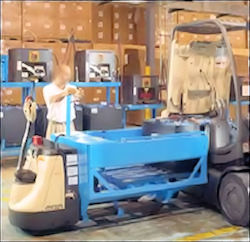Battery Charging and Changing Procedures
An electric forklift is designed to operate for one shift and then be charged on the next shift or overnight.
Some employers routinely change batteries instead of charging them in the vehicle. The discharged battery is removed from the forklift and a charged battery is installed in its place.
Batteries are heavy and contain sulfuric acid that is highly corrosive and could be splashed on personnel servicing or changing batteries. Toward the end of the battery charging process, batteries can give off highly explosive hydrogen gas. Contact with battery cells can cause electrical short circuits, which can burn unprotected skin.
Only trained personnel should charge and change batteries in electric forklifts.
In addition to training in battery changing and charging procedures, these employees should be trained on emergency procedures in the event of an acid splash, including how to use eyewash and shower facilities.
Always follow your facility's specific safety procedures.
Follow the recharger manufacturer's recommendations for attaching and removing cables and for proper operation of your equipment. Requirements and recommended practices for charging batteries include:
- Properly position forklifts and apply brakes before attempting to change or charge batteries.
- Use a lifting beam or equivalent material handling equipment when lifting the battery. Do not use a chain with two hooks. This may cause distortion and internal damage.
- Charge batteries in the designated battery charging area.
- Provide an area for flushing and neutralizing spilled electrolyte, for fire protection, for protecting charging apparatus from damage by forklifts, and for adequate ventilation for dispersal of fumes from gassing batteries.
Knowledge Check Choose the best answer for the question.
7-3. Batteries are heavy and contain _____ and could be splashed on personnel servicing or changing batteries.
You forgot to answer the question!


